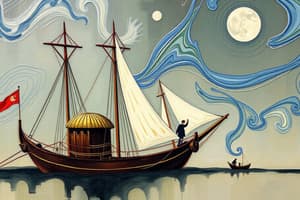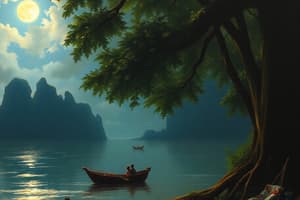Podcast
Questions and Answers
INSTALLATION ART is often designed for a specific ______.
INSTALLATION ART is often designed for a specific ______.
place
Modern Art spans from the 1880s to the ______
Modern Art spans from the 1880s to the ______
1970s
The first awardee of the National Artist of the Philippines was ______ Amorsolo.
The first awardee of the National Artist of the Philippines was ______ Amorsolo.
Fernando
The performing arts include music, dance, and ______.
The performing arts include music, dance, and ______.
The ______ period refers to the time before the colonizers reached the Philippine islands.
The ______ period refers to the time before the colonizers reached the Philippine islands.
The highest national recognition in the Philippines for artists is the Order of the National ______ Award.
The highest national recognition in the Philippines for artists is the Order of the National ______ Award.
Fine arts are described as art forms created primarily for their ______ rather than practical use.
Fine arts are described as art forms created primarily for their ______ rather than practical use.
In dance, ______ is a theatrical form that emphasizes a regulated order of body movement.
In dance, ______ is a theatrical form that emphasizes a regulated order of body movement.
In the contemporary arts, assemblage is a form of sculpture composed of ______ objects.
In the contemporary arts, assemblage is a form of sculpture composed of ______ objects.
The process of crossing one group of threads to create fabric is known as ______.
The process of crossing one group of threads to create fabric is known as ______.
Flashcards are hidden until you start studying
Study Notes
Art Overview
- Art represents the expression or application of human creativity.
- Modern Art spans from the 1880s to the 1970s, featuring movements such as Fauvism, Impressionism, and Surrealism.
- Contemporary Art refers to artworks created by living artists in the present day.
Philippine Art History
- Pre-colonial Art existed before colonizers arrived in the Philippines.
- Spanish Colonial Art emerged with the arrival of Spaniards, altering indigenous artistic practices.
- American colonization introduced public education, while Japanese occupation was brief during the 1940s.
- Contemporary Arts in the Philippines often reflect visions of a "New Society."
Visual Arts
- Visual Arts encompass a range of disciplines appreciated mainly through sight.
- Fine Arts refers to art created for aesthetic purposes rather than functional use.
Categories of Visual Arts
- Drawing: Marking surfaces with instruments.
- Painting: Application of pigment or color.
- Sculpture: Creation of three-dimensional art using hard/plastic materials.
- Architecture: Art of designing buildings.
- Art Prints: Art created through pressing inked carved images.
Decorative Arts/Crafts
- Decorative Arts emphasize both beauty and functionality.
- Weaving: Intersecting threads in textiles.
- Jewelry Making: Crafting ornamental pieces.
- Furniture Making: Creating functional household items.
- Pottery: Forming objects with clay.
- Metal Crafts: Artworks crafted from metals.
Contemporary Arts
- Contemporary Art introduces new, unusual forms.
- Assemblage: Sculpture made from found objects.
- Collage: Arranging a variety of materials.
- Installation Art: Site-specific large-scale mixed-media works.
- Digital Art: Art created via digital technologies.
- Land Art: Art directly made within the landscape.
Performing Arts
Music
- Music involves the manipulation of sound and silence.
- Art Music: Recognized for high aesthetic value (classical).
- Popular Music: Aimed at large audiences.
- Traditional Music: Folk songs passed through generations.
- Choral Music: Music sung by choirs.
Dance
- Dance is characterized by regulated body movements.
- Ballet: A theatrical dance form.
- Improvisational Dance: Unplanned movement creation.
- Hip-Hop Dance: Various street dance styles.
- Modern Dance: Highly expressive style.
- Contemporary Dance: Innovative, interpretive dance.
Theater
- Theater involves live performances by actors.
- Mime: Silent expression through movement.
- Puppetry: Manipulation of puppets for storytelling.
- Tragedy: Drama focusing on human suffering.
- Traditional Theater: Combines acting, music, and narration.
- Opera: Staged drama with music.
- Musical Theater: Integrates acting, singing, and dancing.
National Artist of the Philippines
- Order of the National Artist Award: Highest recognition for Filipino artists.
- Administered by the NCCA and CCP; established by Proclamation No. 1001 in 1972.
- Fernando Amorsolo: First recipient of the award.
Categories of National Artists
- Literature, Film and Broadcasting, Architecture, Music, Dance, Theater, Visual Arts.
Insignia of the Order
- Grand Collar featuring circular links representing the arts and an eight-pointed sun emblematic of the CCP’s motto.
Indigenous Art
- Indigenous Art refers to creations made by the indigenous people of the Philippines.
GAMABA Award
- GAMABA Gawad sa Manlilikha ng Bayan: Award recognizing practitioners preserving Filipino arts.
- Established in 1992 through Republic Act No. 7355.
- Emblem features a representation of a human form on traditional fabric.
Benefits for GAMABA Awardees
- Recognition as "Manlilikha ng Bayan."
- Gold-plated medallion and lifetime emoluments, totaling Php 200,000.
- Monthly stipends and a state funeral.
National Living Treasures
- Highlights include:
- Ginaw Bilog: Ambahan poetry.
- Masino Intaray: Master of various musical instruments.
- Lang Dulay: Renowned weaver of traditional textiles.
Significance of Representation
- Manunggul Jar: Embodies the significance of waterways to ancestors.
- Bahay Kubo: Represents Filipino sociability and community spirit.
- Metaphor of Body and Jar: Concept linking Filipino identity to physical and spiritual aspects.
Heritage and Cultural Institutions
- National Heritage: Cultural significance passed down generations.
- Cultural Heritage: Expression of community lifestyles.
- NCCA: Oversees cultural policies and initiatives in the Philippines.
- CCP: Premier venue and home to artistic companies.
- NHCP: Promotes Philippine history and cultural heritage through various means.
Studying That Suits You
Use AI to generate personalized quizzes and flashcards to suit your learning preferences.




